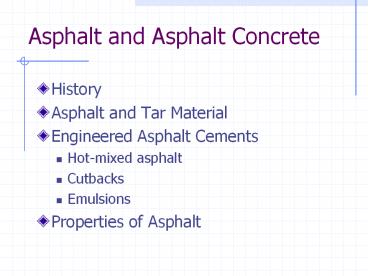Asphalt and Asphalt Concrete - PowerPoint PPT Presentation
Title:
Asphalt and Asphalt Concrete
Description:
Rock asphalt Kentucky, Texas. sandstone impregnated with asphalt. 'Tar' sands ... Alternative Grading System. 232. 40. 400. 4000. AC-40. 232. 50. 350. 3000 ... – PowerPoint PPT presentation
Number of Views:3125
Avg rating:3.0/5.0
Title: Asphalt and Asphalt Concrete
1
Asphalt and Asphalt Concrete
- History
- Asphalt and Tar Material
- Engineered Asphalt Cements
- Hot-mixed asphalt
- Cutbacks
- Emulsions
- Properties of Asphalt
2
History
- 3500 B.C. natural bitumen used to line reservoirs
by the Greeks - First US asphalt in NY and NJ
- Automobile drove the ACC industry
3
(No Transcript)
4
Bitumen and Asphalt
- Bitumen non-volatile hydrocarbon, soluble in
carbon disulfide, very complex material structure - Coal tar, asphalt (processed oil residue)
- Asphalt (combination of asphaltine, resin, oil)
- Asphaltine (C/Hgt0.8)
- Resin (0.8gtC/Hgt0.6)
- Oil (C/H lt 0.6)
- Specific Gravity 0.95 1.05
5
(No Transcript)
6
(No Transcript)
7
Asphalt Characterization
- Flash Point temperature at which a substance
will ignite with a open flame - Rolling Thin-Film Oven indicator of the aging
effect of short term high temperatures when
producing ACC. - Viscosity rotational viscometer measures the
viscosity at a standard temperature (135C) - Complex Shear Modulus dynamic shear rheometer
- Flexural Creep bending beam rheometer measure
creep stiffness - Tensile Strength
8
(No Transcript)
9
Engineered Asphalt Cement
- Hot mixed asphalt (pavements)
- Viscous semi-solid
- Flows for heating into liquid range
- Cutback asphalt
- Viscous liquid
- Cut with oil distillates
- Emulsion asphalt
- Viscous liquid
- Cut with water
10
Emulsions Asphalt Binder Liquefied with Water
-
Water
-
reduces viscosity
è
Emulsifier gives surface charge to asphalt
droplets suspended
è
in water medium
Anionic
Negative charge
Ÿ
Alkaline (Basic) aggregate
Ÿ
Good with limestones (positive charge)
Ÿ
Cationic
Positive charge
Ÿ
Acidic aggregate
Ÿ
Good with silica gravels (negative charge)
Ÿ
Consistency controlled by amount of water
è
Stability controlled by choicer of emulsifier
è
Environmentally correct
è
11
Properties of Asphalt Cement
- Adhesion property to connect dissimilar
materials - Cohesion property to connect similar materials
- 3M scotch tape is adhesive, not cohesive
- Silly putty is cohesive, not adhesive
- Asphalt is adhesive and cohesive
12
Flow properties
- Consistency measure of fluidity at a given
temperature - Absolute Viscosity, poises
- Kinetic Viscosity, centistokes
- Penetration empirical measure of ease to
penetration - Penetration of 1 mm diameter needle.
13
As an example, a PG 64
-
28 is acceptable for use in a
climatic region where the maximum temperature is
64C and the minimum temperature is
-
28C.
14
(No Transcript)
15
Alternative Grading System
Grade Viscosity Abs., Poises Kinetic, cStokes Viscosity Abs., Poises Kinetic, cStokes Penetration Flash Point C
AC-2.5 250 125 220 163
AC-5 500 175 140 177
AC-10 1000 250 80 219
AC-20 2000 300 60 232
AC-30 3000 350 50 232
AC-40 4000 400 40 232
16
Asphalt and Asphalt Concrete
- Asphalt Concrete
- Aggregates
- Properties
- Pavements
- Mixture Design
17
Asphalt Concrete
- Aggregates
- clean and dry aggregates are necessary for
adhesion (no dust, no water) - interlocking nature creates internal friction
which is important to the long-term properties of
the asphalt concrete. - angular shape aggregates 50-80 with 2 angular
faces
18
ACC Importance of Aggregate
- Asphalt cement has no strength at temperatures gt
60C - Stability of pavements in hot weather is due to
internal friction in the aggregates
19
Asphalt Concrete Mixtures
- Mixtures of aggregate and asphalt cement binder
- about 95 aggregate by weight
- about 75 aggregate by volume
- ideally, 3-5 air voids
20
Asphalt Concrete
- Flexibility
- high binder content
- low viscosity binder
- Short-term Loadings
- elastic properties of binder-aggregate matrix
21
Asphalt Concrete
- Long-term Durability
- fluid properties of binder
- dry clean aggregates
- water causes stripping
- strong porous angular stone
- durable aggregates (LA abrasion)
22
Asphalt Concrete
- Workability Ease in which material is handled
and laid and compacted. - poor compaction leads to deformation and the
permeability of water and air. - temperature affects workability
- Strength
- high viscosity binder
- crushed stone aggregates (interlock)
23
Pavement Section
ACC Surface
ACC Base
Granular Subbase
Subgrade
24
Asphalt Pavement Distress
Cracking
Traffic Associated Fatigue
Rutting
25
Asphalt Concrete Applications
- Roofing,
- slurry
- composition shingles
- Sealants
- waterproofing for foundations, etc
- electrical insulation
26
Asphalt Concrete Applications
- Pavements
- Hot Mixed Asphalt Cement
- (asphaltine, resin)
- Emulsions (repairs, small jobs)
- moist or dry aggregates
- hot or cold applications
- no fuel or solvents
- anionic or cationic
27
Asphalt Concrete Applications
- Cutbacks (on the way out)
- RC - flash point in 27C !!!
- hard base (hot regions)
- MC - safer
- softer base (cold regions)
- SC - Road Oils
- rural roads, sealants
28
Primary Distress Modes HMA Pavements
Rutting
Rutting
Fatigue Cracking
Fatigue Cracking
5
-
15 m
Moisture Damage?
Thermal Cracking
29
Temperature Regimes where Distress Predominates
Low
-
temperature thermal
Plexiglas
Shrinkage cracking
Intermediate
-
temperature
Salt Water
traffic
-
associated fatigue
Consistency
Taffy
High
-
temperature
Molasses
rutting
-
25
75
50
25
0
Approximate Temperature,
C































